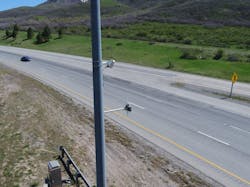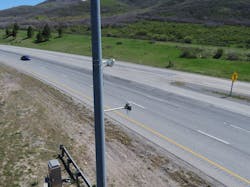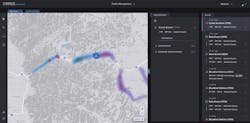Improving road safety through connected vehicle technology in Utah
The state of Utah is often referred to as the Crossroads of the West, positioned at the junction of major interstate highways and the transcontinental railroad.
Now it is a technology hub and the population is projected to nearly double by 2050. This presents a unique transportation challenge and stresses the need for innovation and collaboration. The Utah DOT (UDOT) has been developing intelligent transportation system (ITS) projects for years, and in 2018 created the Transportation Technology Group dedicated to expanding the deployment of new technologies. UDOT’s vision, mission, and strategic goals drive every project. Central to these are safety, mobility, optimizing investment, innovation, and quality of life. UDOT believes that through leveraging connected vehicle technologies, the department can meet these goals and transform transportation in safer and more efficient ways.
UDOT’s first connected vehicle project was to add transit signal priority (TSP) in an effort to improve bus schedule reliability. UDOT decided on dedicated short range communication (DSRC) technology to achieve this, adding the roadside units (RSU) to the traffic signals and the onboard units (OBU) to the buses. It became operational in 2017 on one corridor along the west side of Salt Lake County. Redwood Road is a busy commuter route that crosses multiple freeways and serves multiple schools and commercial areas, including the state’s largest community college. By giving priority to buses that had high passenger occupancy and met a lateness threshold, the Utah Transit Authority (UTA) was able to improve reliability by 6%. Since the buses were only given priority and not preemption, it was not disruptive to other traffic and resulted in an overall system improvement. In 2018 connected vehicle TSP was added to a new bus rapid transit (BRT) system between Provo and Orem, which operates on a six-minute headway. The priority system has improved reliability and helped maintain the bus frequency, which is part of its appeal to users. The overall BRT system has been a success with passenger volumes continuing to exceed expectations.
In 2019 the technology was added to a group of snowplows to provide signal preemption in an effort to improve safety and system reliability. An initial projection by the safety analysis group estimated an 8% decrease in crashes if snowplows were provided signal preemption. It would aid snowplows to clear the road faster to provide for safer travel and restore traffic to normal conditions. The system has only been in use for one season and university research is ongoing, but many anecdotal benefits have been reported by plow operators. These include better platooning, reducing the number of trips required to clear the entire roadway width, and better clearing of left-turn lanes as they can be cleared together with concurrent turn and thru signals. There is less snow left behind at intersections when they have to stop, since they can continue to push the snow through the intersection to the end of the route. All of this results in safer roads.
In 2019 UDOT was awarded a $3 million grant from FHWA for Advanced Transportation and Congestion Management Technologies Deployment (ATCMTD). As part of the ATCMTD grant, connected vehicle technology will be added to more routes to support both TSP and snow plow preemption. The same roadside unit will serve both functions, so both transit and snowplow operations can benefit from the expansion.
Part of the ATCMTD grant is also being used to develop a “V2X (Vehicle to Everything) Connected Vehicle Ecosystem.” Imagine if vehicles could talk to each other and give warning of upcoming danger. You may be driving and wonder why the vehicle in front of you is slowing down, swerving, or making another maneuver when you cannot see around it. You cannot see the hazard but the driver in front of you can. Connected vehicle technology can provide a way for lead vehicles to communicate that danger to others following behind, reducing crashes and making travel safer for all.
CB radio systems have been used for decades by long-haul truckers to communicate with each other not just socially, but to warn each other about upcoming dangers. They can update each other on road and weather conditions, stalled vehicles, and other potential hazards before upstream drivers can see them. The connected vehicle ecosystem is similar in that way. A network of radio antennas on a highway can provide the link between vehicles, where the lead vehicles can communicate road conditions and warn of hazards that trailing vehicles are not aware of and cannot yet see. This can all happen at faster than human speed as on-board computers do all of the sensing and automatically send data over through the cloud to a central system, and in later phases back to other vehicles with on-board radios.
UDOT has partnered with Panasonic to develop this system, using both ATCMTD and state funds. The system consists of four main parts: roadway hardware, hardware on vehicles, software applications, and cloud-based data analytics. The first phase of the project will be complete in the fall of 2020, with the initial data streams providing actionable information to the statewide traffic operations center.
The goal of the first phase is to outfit a group of vehicles and a few select corridors to test the data collection capabilities and the interaction of the software within the system. The corridors were chosen based on crash history and traffic patterns, to find locations that could benefit from the new technology, and have enough traffic to generate data for evaluation. The routes, shown on the map below, include two heavily traveled canyon roads; both serve recreation and ski areas while one is also an interstate highway with high truck and commuter traffic. A few interchanges were chosen for their high number of crashes related to curve speeds to evaluate a curve speed warning application. The routes in and around Park City were chosen to evaluate spot weather warnings based on the frequent winter weather, which can disrupt traffic—particularly on busy ski days.
The OBUs will be first installed in 35 state-owned vehicles that were selected based on the type, age of vehicle, and expected travel patterns. The OBU transmits the “Basic Safety Message” (BSM) to an RSU, which connects to the UDOT fiber optic network and the cloud. The BSM is an automotive standard transmitting the status of multiple systems running on a vehicle, such as the windshield wipers, headlights, traction control, and the airbag. It does not include any personally identifiable information or vehicle make and model, maintaining the driver’s privacy. This BSM transmits 10 times per second to the RSU, which passes it back to the central software at the traffic operations center, where an operator can take action on it. For example, if multiple vehicles report slipping on the roadway, or windshield wipers are engaged, an icy road or weather warning can be posted on an overhead sign to warn drivers both at the location and upstream. In later phases, this warning can be sent directly to the driver in individual vehicles equipped with an OBU and screen, making the information individualized, timely, and actionable. If a BSM reports an airbag deployed, an operator can pinpoint the location on the map instantly and dispatch emergency services to investigate without waiting for reports from drivers.
A seat belt and airbag are physical devices that react to protect the driver after a danger is encountered. The V2X system is designed to protect occupants by identifying hazards and helping drivers avoid them. It helps emergency services take action more quickly to aid in clearing crashes and preventing secondary ones, saving lives and helping others reach their destination in a safe and timely manner.
UDOT currently has 200 RSUs deployed on various routes for these projects. The TSP projects used DSRC technology, while the V2X Ecosystem project is deploying some cellular V2X technology to evaluate its capabilities. These are rapidly evolving technologies with exciting possibilities. UDOT will continue to pursue expansion of connected vehicle technology to meet its strategic goals and improve safety for all drivers.


